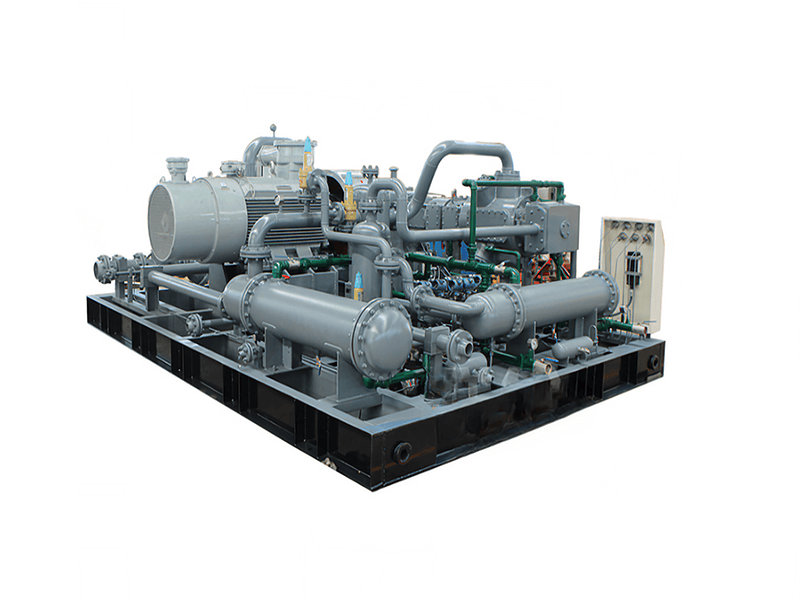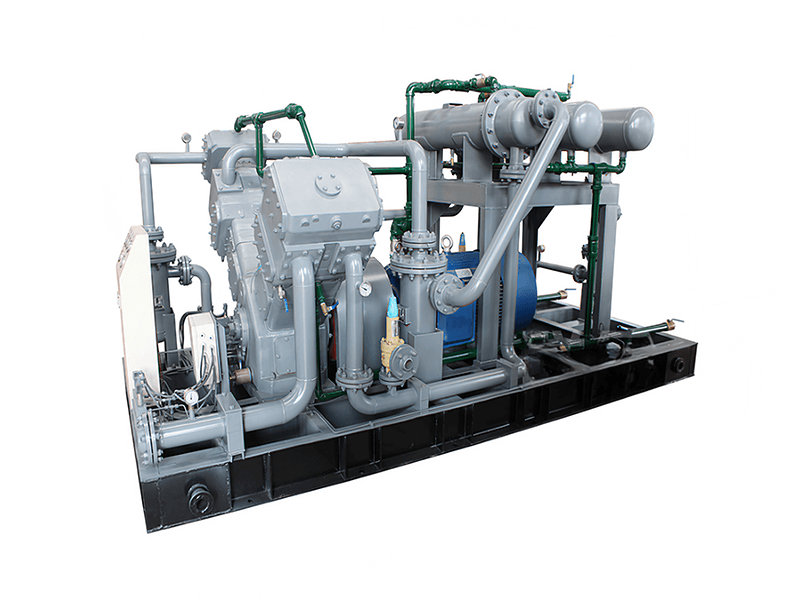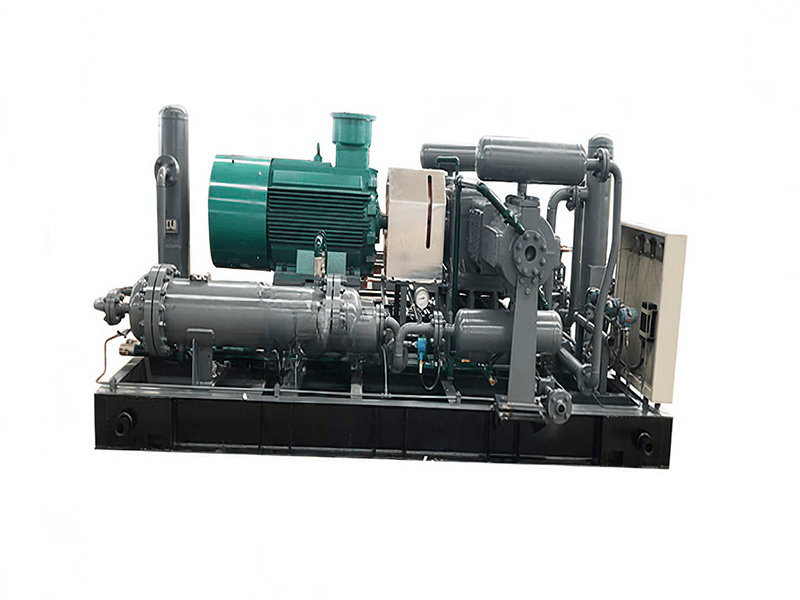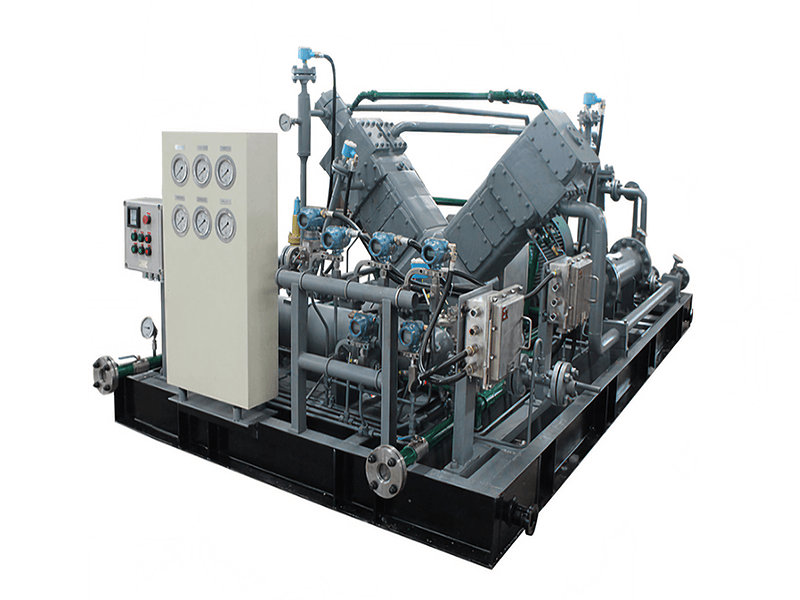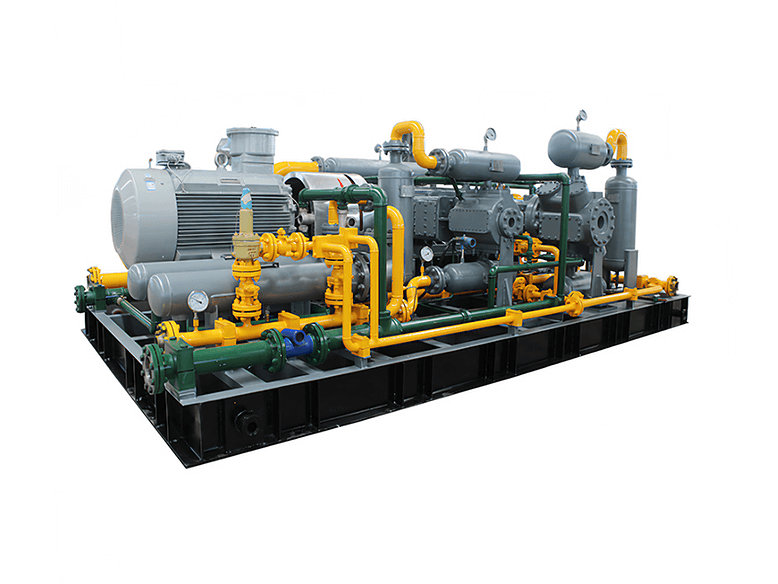Helium, as a non-renewable strategic resource, is irreplaceable in the fields of low-temperature superconductivity, aerospace propulsion, semiconductor manufacturing, etc. Its storage and transportation process faces two core challenges: First, helium liquefaction needs to be close to absolute zero (-268.9℃), which consumes extremely high energy; second, the diameter of helium molecules is only 0.26nm, which has strong permeability and is easy to leak, resulting in resource loss and safety hazards. Piston compressors have become the core equipment of helium storage and transportation systems with their high pressure ratio, low flow adaptability and high reliability. This article discusses the engineering practice path of piston compressors in helium storage and transportation from the two dimensions of energy efficiency optimization and safe operation, combined with key technological breakthroughs and typical cases.
Ⅰ. Technical challenges and core requirements of helium storage and transportation
1. Energy efficiency bottleneck
High liquefaction energy consumption: Helium liquefaction requires multi-stage compression and deep refrigeration, and the unit liquid helium energy consumption of traditional processes reaches 25~30kWh/m³.
Large compression heat loss: 30%~40% of the energy in the operation of the piston compressor is converted into heat. If it is not effectively recovered, it will increase the energy consumption of the system.
2. Safety risks
Leakage risk: Helium has strong permeability, and a small sealing defect under high pressure (≥15MPa) can cause an annual leakage rate of more than 5%.
Low-temperature embrittlement of materials: The extremely low temperature environment of the liquefaction link can easily cause brittle fracture of metal parts.
Impurity contamination: The mixing of impurities such as nitrogen and hydrogen will significantly increase the liquefaction temperature and reduce the purity of liquid helium.
3. Economic constraints
The storage and transportation costs of helium account for more than 60% of the total cost of the industrial chain, and the unit cost needs to be reduced through energy efficiency optimization and long-term operation of equipment.
Ⅱ. Key technologies for energy efficiency optimization
1. Multi-stage compression and thermodynamic cycle optimization
Stage configuration: 4~6-stage compression, single-stage compression ratio ≤2.5, combined with Brayton or Claude cycle, the total efficiency is increased by 20%~30%.
Interstage cooling enhancement: The first two stages use liquid nitrogen pre-cooling (-196℃), and the last two stages integrate helium expanders, with a temperature gradient control accuracy of ±0.5K.
2. Waste heat recovery and energy integration
Compression heat utilization: The heat at the compressor outlet (80~120℃) is used to regenerate molecular sieves or preheat intake air, and the system energy efficiency is improved by 12%~18%.
Cold energy recovery: The cold energy released in the liquefaction process is used to pre-cool subsequent gases and reduce refrigeration power consumption.
3. Variable frequency drive and intelligent control
Permanent magnet synchronous motor: With vector control inverter, the load range is extended to 20%~110%, and the partial load efficiency is improved by 15%.
Dynamic parameter optimization: Based on model predictive control (MPC), the number of compression stages, cooling flow and expander opening are adjusted in real time.
Ⅲ. Safe operation guarantee technology
1. Low temperature resistant materials and anti-penetration seals
Material: Cylinders and valves are made of 316LN stainless steel or Inconel 718 alloy, with impact toughness > 80J at -269℃.
Sealing system:
Main seal: metal bellows + flexible graphite ring, resistant to 20MPa high pressure and -200℃ low temperature.
Auxiliary seal: online monitoring by helium mass spectrometer leak detector, leakage rate ≤1×10⁻⁹ Pa·m³/s.
2. Impurity control and purification integration
Front-end purification: palladium membrane purifier is configured at the compressor inlet, and the removal rate of hydrogen and nitrogen impurities is > 99.99%.
Online monitoring: quadrupole mass spectrometer (QMS) detects helium purity in real time (≥99.999%).
3. Intelligent safety monitoring system
Multi-sensor fusion: vibration, temperature, pressure sensors and acoustic emission probes are linked, and the fault identification accuracy is > 95%.
Digital twin warning: Build a three-dimensional model of the compressor to predict seal failure and material fatigue cycle, and shorten the maintenance response time by 70%.

IV. Typical case analysis
Case 1: Energy efficiency upgrade project of the US Strategic Helium Reserve
Background: The world's largest helium reserve facility, annually processing 480 million cubic meters of natural gas containing helium, and the original system unit energy consumption is 28kWh/m³.
Technical solution:
Introducing a five-stage piston compressor, integrating liquid nitrogen pre-cooling and waste heat recovery, and improving interstage cooling efficiency by 40%.
Adopting variable frequency drive + AI energy efficiency algorithm to dynamically optimize compression ratio and refrigeration power distribution.
Results: Unit liquid helium energy consumption is reduced to 19kWh/m³, annual electricity saving is 120 million degrees, and the investment payback period is 3.8 years.
Case 2: European XFEL superconducting accelerator helium cryogenic system
Challenge: Supply 1.8K superfluid helium for the 1.7km superconducting linear accelerator, requiring continuous operation for 10 years without failure.
Innovative design:
Six-stage oil-free piston compressor, outlet pressure 20MPa, piston rod made of carbon fiber composite material (weight reduction of 30%).
The sealing system is equipped with a double-layer metal honeycomb structure, with a leakage rate of <5×10⁻¹⁰ Pa·m³/s.
The digital twin system maps the compressor status in real time, and the fault warning accuracy rate is 98%.
Results: 8 years of continuous operation, zero liquid helium supply interruption time, and a 35% reduction in operation and maintenance costs.
Case 3: China Ningxia Helium Liquefaction Plant
Demand: Processing low-concentration helium-containing natural gas (0.5%~1%), with an annual output of 30 tons of liquid helium.
Solution:
Three-stage piston compressor + cryogenic adsorption purification, helium recovery rate increased from 75% to 88%.
Integrated Internet of Things platform, remote monitoring of compressor vibration and sealing status, leakage response time ≤10 seconds.
Waste heat drives absorption refrigerator, and the overall energy efficiency is improved by 15%.
Benefit: Unit liquid helium cost decreased by 22%, reaching the domestic leading level.
V. Industry Challenges and Countermeasures
1. Insufficient long-term effectiveness of sealing materials
Countermeasures: Develop MOF (metal organic framework) coating sealing materials to reduce permeability by 90%.
2. Low recovery rate of high-purity helium
Countermeasures: Promote closed-loop circulation process to increase helium recovery rate to more than 95%.
3. High initial investment cost
Countermeasures: Modular design of compression-liquefaction unit to reduce construction cost by 30%.
VI. Future Development Trends
Ultra-high pressure liquefaction technology: Develop 30MPa compressor to support the demand for liquid helium in deep space exploration.
Zero leakage sealing system: Based on quantum sensing technology, the leakage rate is ≤1×10⁻¹² Pa·m³/s.
Green power drive integration: Couple photovoltaic/wind power to build a zero-carbon helium liquefaction plant.
Intelligent process chain: Machine learning optimizes the parameters of the entire process of purification-compression-liquefaction, and energy consumption is reduced by another 10%~15%.
Conclusion
Piston compressors have the dual mission of optimizing energy efficiency and operating safely in helium storage and transportation. Through breakthroughs in multi-stage thermodynamic cycles, intelligent control, and cryogenic sealing technology, they have made significant progress in controlling liquefaction energy consumption and preventing leakage risks. Engineering practices in the United States, Europe, and China have shown that high-efficiency design and intelligent operation and maintenance can significantly reduce the cost of helium storage and transportation and improve reliability. In the future, with the deep integration of ultra-high pressure technology and green energy, piston compressors will accelerate the evolution of the helium industry chain towards efficiency, safety, and sustainability.














